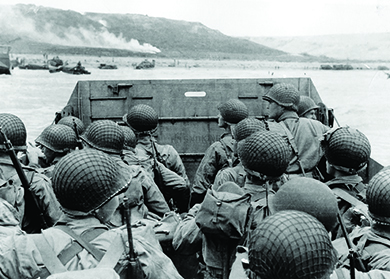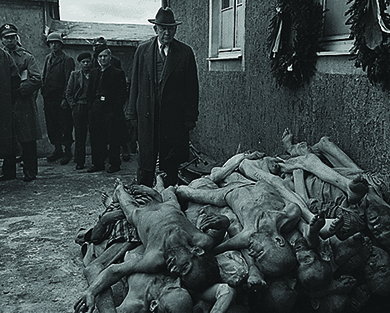| << Chapter < Page | Chapter >> Page > |

Nazi Germany was not ready to surrender, however. On December 16, in a surprise move, the Germans threw nearly a quarter-million men at the Western Allies in an attempt to divide their armies and encircle major elements of the American forces. The struggle, known as the Battle of the Bulge, raged until the end of January. Some ninety thousand Americans were killed, wounded, or lost in action. Nevertheless, the Germans were turned back, and Hitler’s forces were so spent that they could never again mount offensive operations.
The Holocaust, Hitler’s plan to kill the Jews of Europe, had begun as early as 1933, with the construction of Dachau, the first of more than forty thousand camps for incarcerating Jews, submitting them to forced labor, or exterminating them. Eventually, six extermination camps were established between 1941 and 1945 in Polish territory. Jewish men, women, and children from throughout Europe were transported to these camps in Germany and other areas under Nazi control. Although the majority of the people in the camps were Jews, the Nazis sent Roma (gypsies), gays and lesbians, Jehovah’s Witnesses, and political opponents to the camps as well. Some prisoners were put to work at hard labor; many of them subsequently died of disease or starvation. Most of those sent to the extermination camps were killed upon arrival with poisoned gas. Ultimately, some eleven million people died in the camps. As Soviet troops began to advance from the east and U.S. forces from the west, camp guards attempted to hide the evidence of their crimes by destroying records and camp buildings, and marching surviving prisoners away from the sites ( [link] ).

The horrors of the concentration camps remained with the soldiers who liberated them long after the war had ended. Below is an excerpt of the recollection of one soldier.
Our first experience with the camp came as a traumatic shock. The first evidence of the horrors to come was a string of forty railway cars on a railway spur leading into the camp. Each car was filled with emaciated human corpses, both men and women. A hasty search by the stunned infantry soldiers revealed no signs of life among the hundreds of still bodies, over two thousand in all.
It was in this atmosphere of human depravity, degradation and death that the soldiers of my battalion then entered the camp itself. Almost all of the SS command guarding the camp had fled before our arrival, leaving behind about two hundred lower ranking members of the command. There was some sporadic firing of weapons. As we approached the confinement area, the scene numbed my senses. Dante’s Inferno seemed pale compared to the real hell of Dachau. A row of small cement structures near the prison entrance contained a coal-fired crematorium, a gas chamber, and rooms piled high with naked and emaciated corpses. As I turned to look over the prison yard with un-believing eyes, I saw a large number of dead inmates lying where they has fallen in the last few hours or days before our arrival. Since all of the bodies were in various stages of decomposition, the stench of death was overpowering. The men of the 45th Infantry Division were hardened combat veterans. We had been in combat almost two years at that point. While we were accustomed to death, we were not able to comprehend the type of death that we encountered at Dachau.
—Felix L. Sparks, remarks at the U.S. Holocaust Museum, May 8, 1995

Notification Switch
Would you like to follow the 'U.s. history' conversation and receive update notifications?